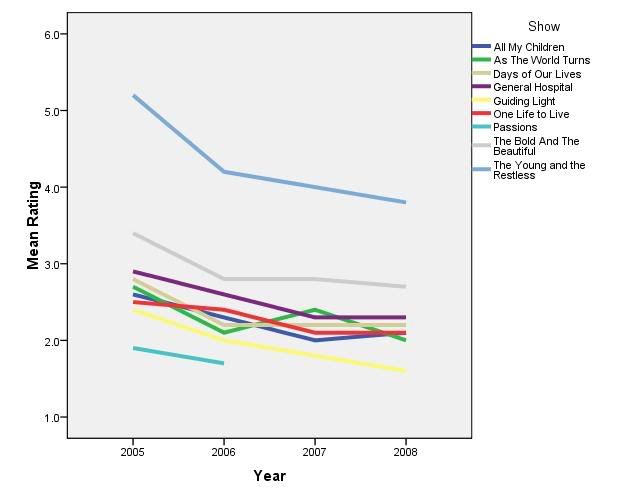I have tried to prove here, elsewhere that:
- the rate of decline is virtually identical for all the soaps; excluding small variations (where soaps jockey for different positions in the rank order) they've all gone down in lockstep
- no 'resurgence' (not even GH's celebrated early 80s triumph) has had any long-term impact on the decline process that started in the 1970s or earlier (and became clearly manifest by 1980)
- indeed, in the last decade, the rate of decline in daytime has mirrored that of primetime, suggesting that the problem may be more related to "broadcast TV" than soaps in particular.
I've been called naive, immature and misguided for this. I still think I am right :). When the same thing happens to every show, you have to believe it is something about the industry or the genre or the platform.
What I believe is that the creative state of soap CAN influence its relative position. For example, I think the reason Y&R has been consistently #1 for almost two decades relates, in part, to its use of a consistent cast, production style, narrative throughline from the beginning. "Jill and Kay", two presently front burner characters, were both on the front burner in 1973. I also think CBS and her affiliates have been more supportive of Y&R, scheduling the show during a higher-viewership time (lunchtime, for many), and not punting the show all over the daypart.
But, even Y&R has declined, more or less, at the same rate as all the other shows. Which tells me, as someone who thinks a lot about "systems level processes" in my day job, that this is more about factors extrinsic to soaps.
In the past, therefore, I (erroneously?) concluded that all soaps are going to follow this death trajectory. By using some simplified projections (a linear rate of decline that is constant for all soaps) I went so far as to say the last soap, Y&R, might be cancelled in 2016.
Now, I think I might be wrong. At the behest of several posters at SON, I redid the above analysis, making a few changes: First, I did not require linear decline (that is important, because it means that if any show seems to be "levelling off" in decline, this new model will pick that up). Second, I did not impose the same decline slope for all shows -- I let the actual data from the past decade, for each show, determine the decline slope. Using that, and picking an arbitrary cancellation criterion of Household Neilsen Rating = 1.5 (which I picked out of thin air), some interesting things happened.
- First, I replicated some of my previous findings: It would appear that ATWT, DOOL, AMC and OLTL are all on a pretty unstoppable "death" trajectory (but only if my assumptions are right!).
- Second, three soaps (GH, Y&R, B&B) would seem to have the possibility of levelling off. Which means, if you project into the reasonable future (e.g., 2013), there is no reason to project (on strictly quantitative groups) that they will reach the cancellation threshold.

Is the rate of decline REALLY levelling off? Well, I plotted the four-year HH ratings (which I realize many don't care about, because it's all about the 18-49 female demo, but I care more about how many absolute Live+Same Day viewers a show gets), and sure enough, the slope of descent has apparently slowed from higher rates earlier in the decade.

"A little hope, a little romance, a big fat bulge in the hero's pants" (from Soaps in the Bunker).

No comments:
Post a Comment